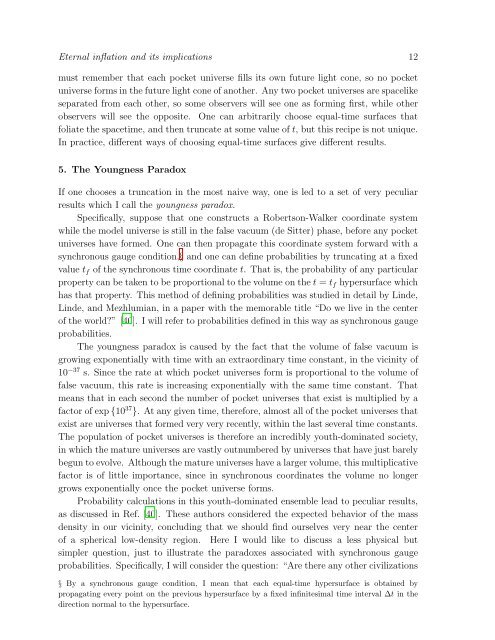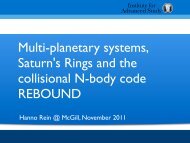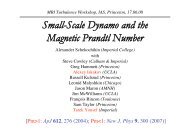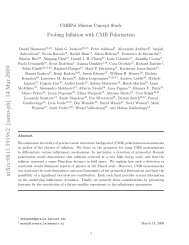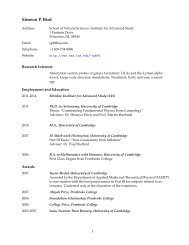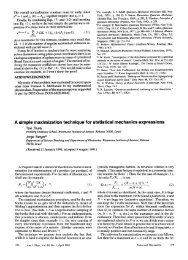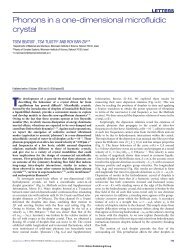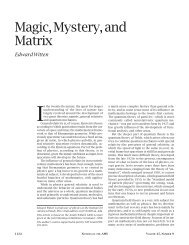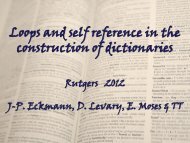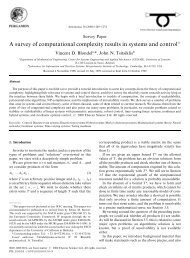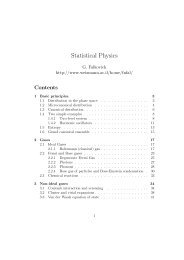Eternal inflation and its implications
Eternal inflation and its implications
Eternal inflation and its implications
Create successful ePaper yourself
Turn your PDF publications into a flip-book with our unique Google optimized e-Paper software.
<strong>Eternal</strong> <strong>inflation</strong> <strong>and</strong> <strong>its</strong> <strong>implications</strong> 12<br />
must remember that each pocket universe fills <strong>its</strong> own future light cone, so no pocket<br />
universe forms in the future light cone of another. Any two pocket universes are spacelike<br />
separated from each other, so some observers will see one as forming first, while other<br />
observers will see the opposite. One can arbitrarily choose equal-time surfaces that<br />
foliate the spacetime, <strong>and</strong> then truncate at some value of t, but this recipe is not unique.<br />
In practice, different ways of choosing equal-time surfaces give different results.<br />
5. The Youngness Paradox<br />
If one chooses a truncation in the most naive way, one is led to a set of very peculiar<br />
results which I call the youngness paradox.<br />
Specifically, suppose that one constructs a Robertson-Walker coordinate system<br />
while the model universe is still in the false vacuum (de Sitter) phase, before any pocket<br />
universes have formed. One can then propagate this coordinate system forward with a<br />
synchronous gauge condition,§ <strong>and</strong> one can define probabilities by truncating at a fixed<br />
value t f of the synchronous time coordinate t. That is, the probability of any particular<br />
property can be taken to be proportional to the volume on the t = t f hypersurface which<br />
has that property. This method of defining probabilities was studied in detail by Linde,<br />
Linde, <strong>and</strong> Mezhlumian, in a paper with the memorable title “Do we live in the center<br />
of the world?” [40]. I will refer to probabilities defined in this way as synchronous gauge<br />
probabilities.<br />
The youngness paradox is caused by the fact that the volume of false vacuum is<br />
growing exponentially with time with an extraordinary time constant, in the vicinity of<br />
10 −37 s. Since the rate at which pocket universes form is proportional to the volume of<br />
false vacuum, this rate is increasing exponentially with the same time constant. That<br />
means that in each second the number of pocket universes that exist is multiplied by a<br />
factor of exp {10 37 }. At any given time, therefore, almost all of the pocket universes that<br />
exist are universes that formed very very recently, within the last several time constants.<br />
The population of pocket universes is therefore an incredibly youth-dominated society,<br />
in which the mature universes are vastly outnumbered by universes that have just barely<br />
begun to evolve. Although the mature universes have a larger volume, this multiplicative<br />
factor is of little importance, since in synchronous coordinates the volume no longer<br />
grows exponentially once the pocket universe forms.<br />
Probability calculations in this youth-dominated ensemble lead to peculiar results,<br />
as discussed in Ref. [40]. These authors considered the expected behavior of the mass<br />
density in our vicinity, concluding that we should find ourselves very near the center<br />
of a spherical low-density region. Here I would like to discuss a less physical but<br />
simpler question, just to illustrate the paradoxes associated with synchronous gauge<br />
probabilities. Specifically, I will consider the question: “Are there any other civilizations<br />
§ By a synchronous gauge condition, I mean that each equal-time hypersurface is obtained by<br />
propagating every point on the previous hypersurface by a fixed infinitesimal time interval ∆t in the<br />
direction normal to the hypersurface.


